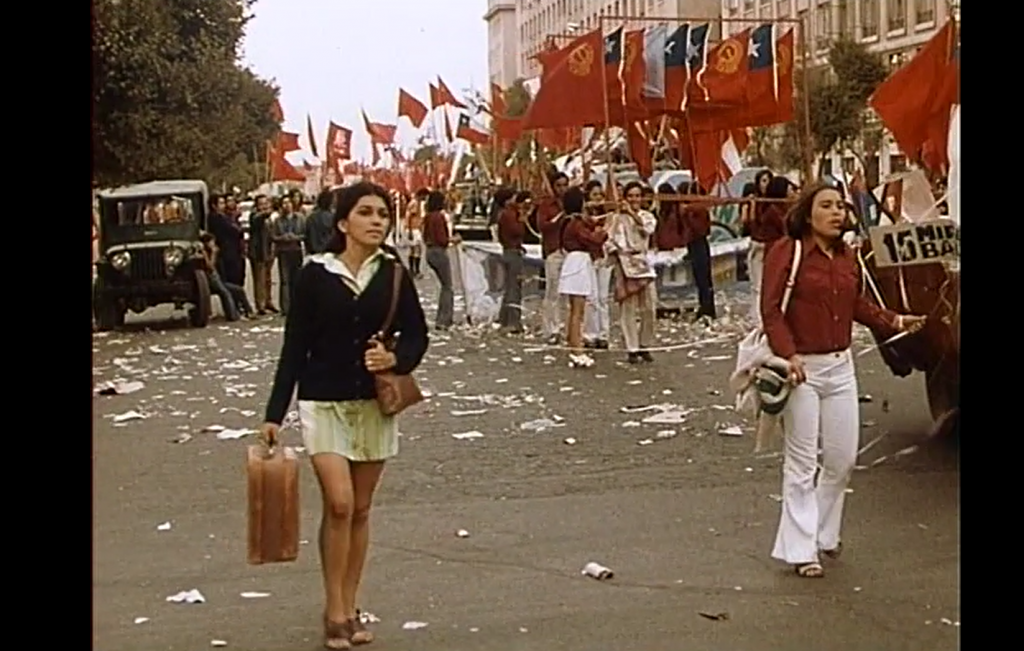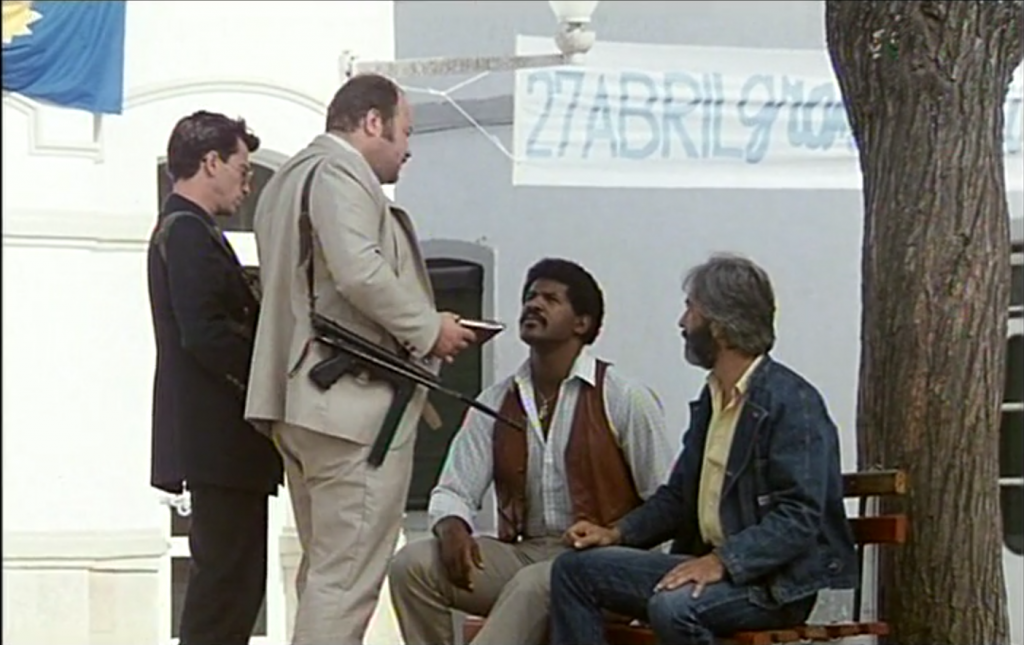by Claudia Sandberg
Claudia Sandberg is the author of Peter Lilienthal : A Cinema of Exile and Resistance.
Sitting at a wooden bench, the young woman Marcela follows the teacher attentively. She has decided to take part in the literacy campaign that was launched by the Unidad Popular government. In a group with other woman, they have gathered in the meeting place and school of the shanty town community La Victoria, situated at the fringes of the Chilean capital, to get trained for this task. The teacher in front holds up a poster that shows a family of three generations. Below appears the Spanish word HOGAR (home). Marcela protests that this image surely does not represent the reality of many people. The other women chime in by referring to their own situation; they are married, divorced, or widowed, they live alone, with their children or with their parents. The word home means something different to each one of them.

This scene from Peter Lilienthal’s feature La Victoria shows Chile just before the parliamentary elections, in March of 1973. The main protagonist, Marcela, is a typist who came to Santiago to find work. She accompanies the socialist candidate, Carmen Lazo, on her election campaign. Time and again, the camera roams Santiago’s busy streets, takes part in demonstrations and manifestations, enters public buildings, offices, houses of the rich and poor. The colorful pictures capture Lilienthal’s fascination about projects to empower and integrate lower social classes. He had befriended Chilean artists involved with these transformative social processes. With money from the ZDF and the Verlag der Autoren, La Victoria became a German-Chilean endeavor. The script was written by author Antonio Skármeta, filmmaker Helvio Soto acted as producer and photographer Silvio Caiozzi did the camera work. The twenty-three-year-old psychology student, Paula Moya, signed up for the main role. Raúl Ruiz, young and quirky, had a cameo appearance in the film. He was working on the feature Palomita Blanca (Little White Dove, 1973/1992) at the same time, a film that also placed a young woman from modest backgrounds at the center of his story and to which the urban space of Santiago serves as backdrop.
Lilienthal always used his cinema as means to draw attention to individuals and groups that existed on the margins of society. This has partly to do with his upbringing. Born in Berlin in 1929 to a Jewish family, he learned as a child that he did not have the same rights as everyone else around him. His mother managed to secure last minute passages to Uruguay in 1939. Relocating from the leafy and sheltered Grunewald to the multicultural Montevideo, the 10-year-old found paradise. He played entire days unsupervised at the beach and spend time with guests and staff kitchen in his mother’s boarding house. Among their friends and guests were émigrés from Europe who arrived with light baggage and traumatic stories. He soon understood why the adults were riddled by sadness and melancholy and listened to Italian operas on the radio. Eventually, the immense pain and sense of loss about the calamity of the Holocaust became his own. He was Jewish as a way of exercising solidarity with those less fortunate. This guided his interests as a filmmaker and other professional activities later: For example, in his role as head of the department Film and Media at the Academy of Arts in Berlin in the 1990s, when discussing how to celebrate three hundred years of the Academy’s existence, he suggested that they should honor artists who were left outside of the Golden Club.


A commissioned filmmaker working with the ZDF since 1969 and known as expert on Latin American matters among the New German filmmakers, Lilienthal made five features and a documentary between 1973 and 2007, which follow social and political conflicts in Central and South American countries. These films screened in West but also East German cinemas and television channels, took part in film festivals, and garnered national and international prizes. La Victoria had the unfortunate fate to serve as epitaph to an unfulfilled dream because on 11 September 1973 a military coup forcefully ended Allende’s reign. Right-wing regimes also ruled Argentina, Uruguay, Nicaragua, or Guatemala at the time. An analysis of authoritarianism, its social implications and possibilities of resistance would occupy Lilienthal’s cinema for many years: Es herrscht Ruhe im Land (Calm Prevails Over the Country, 1976) breathes exile and a spirit of defiance. Shot in Portugal with a local Latin American émigré community and starring renown French actor Charles Vanel, the film expresses hope that a population under siege does not give up their resistance even if they face torture and death. Lilienthal was headed to Nicaragua with photographer Michael Ballhaus in 1979 to capture the Sandinista victory over the dictator, Somoza. This became Der Aufstand (The Uprising, 1980). Made with a non-professional cast, the film focusses on the moral dilemmas of soldiers drafted to fight against their own people, it documented war wounds and traumas. A few years on, Das Autogramm (The Autograph, 1984), based on a novel by Argentine author Osvaldo Soriano, locates sentiments of solidarity in a friendship between a musician and boxer, who team up to repressive evade sanctions of the local authorities. The film was carried by the sound and subversive power of the tango, for which Argentine musician Juan José Mosalini made the soundtrack and acted as the film’s main protagonist. Lilienthal returned to Chile in 1987, where he shot Der Radfahrer vom San Cristóbal (The Cyclist of San Cristóbal, 1987) when it was still ruled by Pinochet’s military government. Among consumerist tendencies and an atmosphere of competition to distract Chileans from the repressive political apparatus, he found found remnants of a collective mindset. Camilo – The lange Weg zum Ungehorsam (Camilo – The Long Road to Disobedience, 2007) ends the Latin American film cycle and Lilienthal’s directing career. The documentary revisits revolution and left-wing ideals. It is the filmmaker’s final plea for reconciliation and peace.
Lilienthal’s films have experienced a second life cycle because they might provide answers to some of today’s political, social, ecological and ethical problems. Ideas and ideals expressed in La Victoria and Der Radfahrer reverberate in the protests that started in Chile in October 2019, when especially young people took to the streets to demand access to education and health care. The films have started to screen on national cinema platforms, in digital television networks, and on local film festivals. They also figure in commemorative events such as the fiftieth anniversary of the Unidad Popular that was celebrated in 2020. Lilienthal’s work finds renewed attention also in Germany. At the occasion of the directors’ ninetieth birthday in 2019, the Deutsche Kinemathek digitalized five of his films and the Akademie der Künste opened the Peter-Lilienthal-Archive. Casa Bertolt Brecht and the Cinematheque in his home city Montevideo, Kino Arsenal and Zeughauskino in Berlin held retrospectives. Such events and initiatives, as well as the monograph Peter Lilienthal: A Cinema of Exile and Resistance all prove that it is a significant contribution to German and Latin American cultural history.
Claudia Sandberg is a film historian and filmmaker. She is employed at the University of Melbourne as Senior Research and Teaching Fellow. Among other works, she created the documentary Hidden Films: A Journey between Exile and Memory (2016) with Alejandro Areal Vélez. Sandberg co-edited the volumes Contemporary Latin American Cinema: Resisting Neoliberalism? (2018) and The German Cinema Book (Second edition, 2020).

